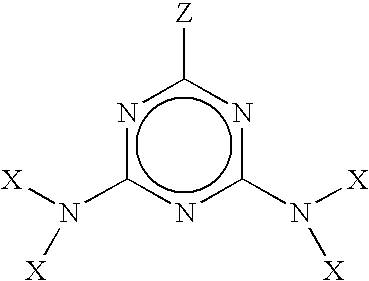Rubber adhesive composition for textile materials
a textile material and adhesive technology, applied in the direction of latex adhesives, etc., can solve the problems of difficult use of rubber adhesive compound for textile materials, high price of resorcinol, and undesirable toxicological properties
- Summary
- Abstract
- Description
- Claims
- Application Information
AI Technical Summary
Problems solved by technology
Method used
Image
Examples
example 1
Preparation of RFL Dip Solution with MF Resin
[0037] The RFL solution with MF resin of the present invention was prepared similar to Comparative Example 1 except that some of the resorcinol was replaced with MF resin. To 1115 g of water was added 8.75 g of 50% sodium hydroxide followed by 82.8 g of 75 wt % resorcinol-formaldehyde resin (Penacolite® Resin R2170) and an additional 43.3 g of a 37 wt % aqueous formaldehyde solution containing 15 wt % methanol as stabilizer. This solution was mixed for 30 minutes at ambient temperature and then the pH was adjusted to approximately 10.5 with ammonium hydroxide to give 1250 g of a 6.6 wt % solids resin solution.
[0038] A latex solution was prepared by adding 566 g of water to 1777 g of a 41 wt % vinyl pyridine SBR latex under mixing. To this latex solution was added 1157 g of the above RF solution and the combined mixture was stirred for 16 hours under ambient conditions to afford 3500 g of a RFL solution.
[0039] To 3299 g of the RFL solut...
example 2
Preparation of RFL Dip Solution with MF Resin Blend
[0040] The procedure of Example 1 was followed with the exception that 201 g of a 23 wt % 80 / 20 blend of a high imino melamine-formaldehyde resin (MF3.2Me1.6) and a highly alkylated melamine-formaldehyde resin (MF5.8Me5.0) was used in place of the high imino alkylated RF resin alone.
example 3
Preparation of Modified RFL Dip Solution with MF Resin
[0044] The RFL solution with MF resin of the present invention was prepared similar to Comparative Example 3 except that some of the resorcinol was replaced with the MF resin.
[0045] To 1095 g of water was added 113 g of 59.3 wt % of an alkyl substituted resorcinol-formaldehyde resin (Grenbond® from Carboshale AS) followed by 41.8 g of 37 wt % aqueous formaldehyde solution containing 15 wt % methanol as stabilizer. This RF solution was mixed for 30 minutes at ambient temperature and the pH was adjusted to approximately 10.5 with ammonium hydroxide to give 1250 g of a 6.6 wt % solids resin solution.
[0046] A latex solution was prepared by adding 566 g of water to 1777 g of a 41 wt % vinyl pyridine SBR latex under mixing. To the latex solution was added 1157 g of the above RF solution and the combined mixture was stirred for 16 hours under ambient conditions to afford 3500 g of a RFL solution.
[0047] To 3287 g of the above RFL sol...
PUM
| Property | Measurement | Unit |
|---|---|---|
| Elastomeric | aaaaa | aaaaa |
| Adhesion strength | aaaaa | aaaaa |
| Ratio | aaaaa | aaaaa |
Abstract
Description
Claims
Application Information
 Login to View More
Login to View More - R&D
- Intellectual Property
- Life Sciences
- Materials
- Tech Scout
- Unparalleled Data Quality
- Higher Quality Content
- 60% Fewer Hallucinations
Browse by: Latest US Patents, China's latest patents, Technical Efficacy Thesaurus, Application Domain, Technology Topic, Popular Technical Reports.
© 2025 PatSnap. All rights reserved.Legal|Privacy policy|Modern Slavery Act Transparency Statement|Sitemap|About US| Contact US: help@patsnap.com

